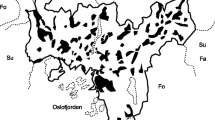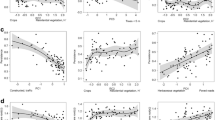Abstract
Several studies have shown that urbanization usually leads to severe biotic homogenizing, i.e. the local extirpation of many native species and the expansion to regional scales of a small group of “urban-adaptors”, some of them exotics. Margarita Island (Venezuela) is a tropical Caribbean island that has undergone an accelerated urban development in the last 40 years. Because the island also has a high bird diversity with several endemic and threatened species, we evaluated the effect of urban development on bird species richness, assemblage structure, seasonal changes and feeding guilds. We defined an urban gradient from areas with high vegetation cover (remnant woodlands) through areas with intermediate vegetation (traditional towns) to areas with next to no vegetation (recent suburbs). Each experimental unit was replicated 3 times and birds were surveyed during the dry and rainy seasons. Richness decreased as urbanization increased, being severely depleted in the recent suburbs. The bird assemblage consisted of native species, including six endemic sub-species, but only one exotic, Columba livia. There were no seasonal changes in assemblage structure. We identified the species most tolerant and most sensitive to urbanization. Omnivorous birds were common along the gradient and granivores were also tolerant to urban development. Specialized insectivores and frugivores were the most negatively affected groups. The considerable amount of native woodland and other vegetation present in the traditional towns we evaluated, and their proximity to natural protected areas, favors the persistence of native bird species in these urban areas on Margarita Island.





Similar content being viewed by others
References
Ayala C (1996) La etnohistoria prehispánica guaiquerí. Antropológica 82:5–127
Beissinger SR, Osborne D (1982) Effects of urbanization on avian community organization. Condor 84:75–83
Blair RB (1996) Land-usage and avian species diversity along an urban gradient. Ecol Appl l6:506–519
Blair RB (2001) Creating a homogenous avifauna. In: Marzluff JM, Bowman R, Donnelly R (eds) Avian ecology and conservation in an urbanizing world. Kluwer Academic Publishers, Massachusetts, pp 459–486
Cam E, Nichols JD, Sauer J, Hines J, Curtis F (2000) Relative species richness and community completeness: birds and urbanization in the Mid-Atlantic States. Ecol Appl 10:1196–1210
Carbó P, Zuria I (2011) The value of small urban greenspaces for birds in a Mexican City. Landsc Urban Plan 100:213–222
Carrascal, L.M. & Palomino, D. 2002. Determinantes de la riqueza de especies de aves en las islas Selvagem y Canarias. Ardeola 49(2), 211–221
Catford JA, Daehler CC, Murphy HT, Sheppard AW, Hardesty BD, Westcott DA (2012) The intermediate disturbance hypothesis and plant invasions: implications for species richness and management. Perspect Plant Ecol 14:231–241
Caula S, Sirami C, Marty P, Martin JL (2010) Value of an urban habitat for the native Mediterranean avifauna. Urban Ecosyst. doi:10.1007/s11252-009-0104-0
Caula S, Villalobos A, Marty P (2013) Seasonal dynamics of bird communities in urban forest of a Mediterranean city (Montpellier, Southern France). Urban Ecosyst. doi:10.1007/s11252-013-0295-2
Chace JF, Walsh JJ (2006) Urban effects on native avifauna: a review. Landsc Urban Plan 74:46–69
Clergeau P, Savard JPL, Mennechez G, Falardeau G (1998) Bird abundance and diversity along an urban–rural gradient: a comparative study between two cities on different continents. Condor 100:413–425
Clergeau P, Croci S, Jokimäki J, Kaisanlahti-Jokimäki ML, Dinetti M (2006) Avifauna homogenisation by urbanisation: analysis at different European latitudes. Biol Conserv 127:336–344
Cruxent JM, Rouse I (1961) Arqueología cronológica de Venezuela. Vol.1. Unión Panamericana-Facultad de Economía de la Universidad Central de Venezuela. Washington DC
CORPOTUR (Corporación de Turismo del Estado Nueva Esparta) (2013) Estadísticas turísticas del Estado Nueva Esparta. Resumen histórico de entrada anual de viajeros al estado Nueva Esparta por medios de transporte 1994–2009. www.corpoturmrgarita.gob.ve (cons. Agosto 2011)
Fernández-Juricic E, Jokimäki J (2001) An habitat island approach to conserving birds in urban landscapes: case studies from southern and northern Europe. Biodivers Conserv 10:2023–2043
Fox JW (2013) The intermediate disturbance hypothesis is broadly defined, substantive issues are key: a reply to Sheil and Burslem. Trends Ecol Evol 28:572–573
Grimm NB, Faeth SH, Golubiewski NE, Redman CL, Wu J, Bai X, Briggs JM (2008) Global change and the ecology of cities. Science 319:756–760
Hilty S (2003) Birds of Venezuela. Princeton University Press, Princeton
Hines JE, Boulinier T, Nichols JD, Sauer JR, Pollock KH (1999) COMDYN: software to study the dynamics of animal communities using a capture-recapture approach. Bird Study 46(suppl):S209–S217
INE (2011) Censo Población y Vivienda. Instituto Nacional de Estadística. República Bolivariana de Venezuela. http://www.ine.gov.ve/index.php?option=com_content&view=category&id=95&Itemid=26. (cons. agosto 2013)
INE (2012) Censo Población y Vivienda. Instituto Nacional de Estadística. República Bolivariana de Venezuela. http://www.ine.gov.ve/demografica/censopoblacionvivienda.asp (cons. agosto 2013)
MARN (1997) Atlas Básico del Estado Nueva Esparta. Ministerio del Ambiente y de los Recursos Naturales- Gobernación Estado Nueva Esparta- Fundación para el Desarrollo del Estado Nueva Esparta, Porlamar
Marzluff JM (2001) Worldwide urbanization and its effects on birds. In: Marzluff JM, Bowman R, Donnelly R (eds) Avian ecology and conservation in an urbanizing world. Kluwer Academic Publisher, Massachusetts
McDonnell MJ, Hahs AK (2008) The use of gradient analysis studies in advancing our understanding of the ecology of urbanizing landscapes: current status and future directions. Landsc Ecol 23:1143–1155
McDonnell MJ, Pickett STA, Groffman P, Bohlen P, Pouyat RV (1997) Ecosystems processes along an urban-to-rural gradient. Urban Ecosyst 1:21–36
McKinney ML, and Lockwood JL (1999) Biotic homogenization: a few winners replacing meny loser in the nest mass extinction. TREE, 14 (11) 450.
McKinney ML (2006) Urbanization as a major cause of biotic homogenization. Biol Conserv 127:247–260
Melles S, Glenn S, Martin K (2003) Urban bird diversity and landscape complexity: species-environment associations along a multiscale habitat gradient. Conserv Ecol [online] URL: http://www.consecol.org/vol7/iss1/art5/.
Milesi FA, Marone L, Lopez de Casenave J, Cueto VR, Mezquida ET (2002) Gremios de manejo como indicadores de las condiciones del ambiente: un estudio de caso con aves y perturbaciones del hábitat en el Monte Central, Argentina. Ecologíca Austral 12:149
Müller N, Ignatieva M, Nilon CH, Werner P, Zipperer, WC (2010) Patterns and trends in urban biodiversity and landscape design. In: Müller et al. Urban Biodiversity and Design. Wiley-Blackwell, pp 123–174
Olden JD, Rooney TP (2006) On defining and quantifying biotic homogenization. Global Ecol Biogeogr. doi:10.1111/j.1466-822X.2006.00214.x
Ortega-Álvarez R, MacGregor-Fors I (2009) Living in the big city: effects of urban land-use on bird community structure, diversity and composition. Landsc Urban Plan 90:189–195
Poulin B, Lefebvre G, McNeil R (1994) Diets of land birds from northeastern Venezuela. Condor 96:354–367
Rahel, FJ, (2002) Homogenization of freshwater faunas. Annu.Rev.Ecol.Syst. 33:291–315
Restall R, Rodner C, Lentino M (2007) Birds of Northern South America: An identification guide. Yale University Press
Sala OE, Stuart Chapin S, Armesto JJ, Berlow E, Bloomfield J, Dirzo R, Huber-Sanwal E, Huenneke LF, Jackson RB, Kinzig A, Leemans R, Lodge DM, Mooney HA, Oesterheld M, Poff NL, Sykes MT, Walker BH, Walker M, Diana H, Wall DH (2000) Global biodiversity scenarios for the year 2100. Science 287:1770–1774
Sanderson EW, Malanding J, Levy M, Redford K, Wannebo AV, Woolmer G (2002) The human footprint and the last of the Wild. Bioscience. doi:10.1641/0006-3568(2002)052[0891:THFATL]2.0.CO;2
Sandstorm UG, Angelstam P, Mikusinski G (2006) Ecological diversity of birds in relation to the structure of urban green space. Landsc Urban Plan 77:39–53
Sanz V (2007) ¿Son las áreas protegidas de la Isla de Margarita suficientes para mantener su biodiversidad? Análisis espacial del estado de conservación de sus vertebrados amenazados. Mem Fund La Salle de Cienc Nat 167:111–130
Sanz V, Oviol L, Medina A, Moncada R (2010) Avifauna del estado Nueva Esparta, Venezuela: recuento histórico y lista actual con nuevos registros de especies y reproducción. Interciencia 35:329–339
Sanz V, Riveros M, Gutiérrez M, Moncada R (2011) Vegetación y uso de la tierra en el estado Nueva Esparta, Venezuela: un análisis desde la ecología del paisaje. Interciencia 36:881–887
South American Classification Committee (SAAC). A classification of the bird species of South America. American Ornithologists’ Union. http://www.museum.lsu.edu/~Remsen/SACCBaseline.html
Torga K, Franchin AG, Júnior OM (2007) A avifauna em uma seção da área urbana de Uberlândia, MG. Biotemas 20:7–17
Vila, P. (1991) Visiones Geohistóricas de Venezuela. Fundación de Promoción Cultural de Venezuela. Caracas, Venezuela. 465pp
Acknowledgments
This work was funded by Council for Scientific and Technological Development of University of Carabobo (CDCH-UC) No 0432–10 and Venezuelan Institute for Scientific Research (IVIC). We are grateful to two anonymous referees whose comments helped to improve the manuscript. To Rodrigo Díaz for his assistance in the field and Elysa Silva for the GIS support in the digitalization of the urban gradient.
Author information
Authors and Affiliations
Corresponding author
Additional information
Virginia Sanz and Sabina Caula have contributed equally to this publication.
Appendix
Appendix
Rights and permissions
About this article
Cite this article
Sanz, V., Caula, S. Assessing bird assemblages along an urban gradient in a Caribbean island (Margarita, Venezuela). Urban Ecosyst 18, 729–746 (2015). https://doi.org/10.1007/s11252-014-0426-4
Published:
Issue Date:
DOI: https://doi.org/10.1007/s11252-014-0426-4




